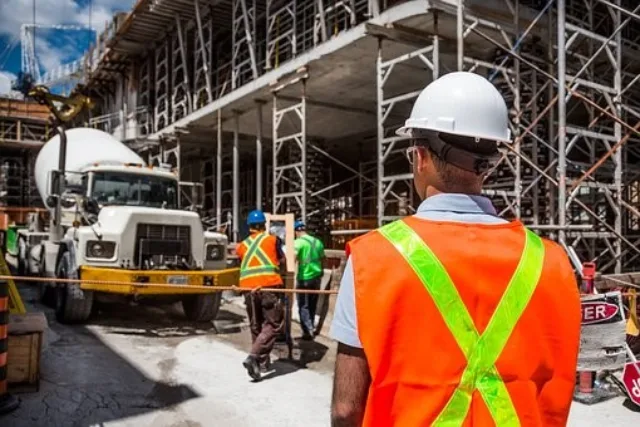15 Essential Tips for Construction Site Safety
Construction sites can be high-risk areas where accidents can happen if proper safety measures are not taken. It is important to follow all OSHA guidelines and remember the hierarchy of controls to eliminate the hazard if possible. Safety on a construction site must be constant and consistent. Here are fifteen crucial tips for construction site safety that can significantly enhance workers’ well-being and protect them from harm.
- Develop a Site-Specific Safety Plan: Begin by developing a comprehensive safety plan that outlines the specific safety protocols and guidelines for the construction site. This plan should address potential hazards, emergency procedures, and protective equipment requirements. Regularly update the plan as the project progresses to incorporate any new risks that may arise.
- Wear Personal Protective Equipment (PPE): Workers should wear appropriate PPE such as hard hats, helmets, safety glasses, goggles, earplugs, earmuffs, gloves, steel-toed boots, high visibility vests, and suits. PPE is the last line of defense designed to protect you and reduce exposure to hazards. While some workers will try to forgo wearing proper PPE due to comfort or convenience, this can be a dangerous practice. Proper PPE could save a life.
- Conduct Site Safety Audits: Construction site safety audits are an important tool for ensuring the safety of workers and compliance with safety regulations. A trained safety professional should conduct the audit. A comprehensive report summarizing the audit findings should be developed, including strengths and weaknesses, recommendations for improvement, and corrective actions to be taken.
- Communicate with Clear Instructions: Clear communication is essential in the construction industry to ensure the safety of workers and the successful completion of projects. Avoid using technical jargon that can be misinterpreted. Using clear and concise language, visual aids, safety briefings, written instructions, and regular communication can help ensure that everyone is on the same page and working towards the same goals.
- Keep the Site Clean and Organized: A clean and organized construction site is safer than a cluttered one. Materials and tools should be stored in designated areas, and debris and waste should be disposed of properly.
- Implement Fall Protection Measures: Falls are a leading cause of construction site accidents. Fall protection measures such as guardrails, safety harnesses, personal fall arrest systems (PFAS), and safety nets should be implemented, as well as a fall rescue plan.
- Train Workers Effectively: Workers should be trained on the proper use of equipment, handling of materials, and emergency procedures. Ensure all workers are trained and certified to operate equipment and perform specific tasks. Excavations and trenches can be particularly dangerous on construction sites, and workers should be taught proper shoring and sloping techniques. Construction site safety training should be ongoing and cover all aspects of construction site safety. Workers should be re-certified periodically.
- Look Out for Mental Health: Construction has the second-highest suicide rate among all industries in the United States. Workers in the construction industry face long, irregular hours in dangerous work environments. Start the conversation with workers about mental health. The probability of accidents is even more significant when exhaustion, mental health issues, and stress are in the equation.
- Hold Safety Meetings and Daily Toolbox Talks: Raise awareness about common hazards on construction sites, such as ladders, scaffolds, electrocution, falls, caught-in and struck-by, excavation, and trenching.
- Post Safety Signs and Provide Adequate Lighting: Safety signage is important in promoting safety on construction sites, and poor lighting can lead to accidents and injuries. Be sure all postings, warning signs, and manufacturer’s information are legible. Adequate lighting should always be provided, especially in areas where work is being performed.
- Secure the Site: Establish secure access points and limit entry to authorized personnel only. Clearly marked hazardous areas restrict entry to those with proper training and authorization. Implement fencing and signage to prevent unauthorized access.
- Regular Equipment Inspections: Regularly inspect and maintain all construction equipment, including scaffolding, cranes, forklifts, aerial lifts, ladders, and power tools. Identify any defective or malfunctioning equipment and promptly remove it from use until it is repaired or replaced.
- Prevent Struck-By Accidents: Implement measures to prevent struck-by accidents, which occur when workers are hit by moving objects or vehicles. Establish a clear traffic control plan, use high-visibility clothing, use spotters/flaggers, install barriers, and designate specific pedestrian areas to separate workers from moving equipment.
- Encourage Proper Lifting Techniques: Train workers on proper lifting techniques to minimize the risk of strains, sprains, and back injuries. Prioritize ergonomics and minimize the risk of injury. Start by assessing the object’s weight and size; if it’s too heavy or awkward, seek assistance or use mechanical aids like forklifts or dollies. When lifting manually, maintain a wide stance with your feet shoulder-width apart for stability. Bend your knees and keep your back straight as you lower yourself to the object’s level. Grasp the load with a firm grip and use the strength in your legs to lift rather than straining your back. Keep the load close to your body and avoid twisting while carrying it. If you need to change direction, pivot your feet instead. Lastly, take your time and move slowly, and if the load is too heavy, consider breaking it into smaller, manageable parts, getting help to lift the load, or using material handling equipment.
- Have an Emergency Response Plan: An emergency plan directs workers on what to do. Having an emergency response plan is crucial for ensuring the safety of employees in case of an emergency. Designating a dedicated team responsible for managing emergencies is essential. Review and update the plan regularly. A well-designed evacuation plan can help minimize injuries and loss of life in a crisis.
Construction site safety should be a top priority for any construction project. Implementing these 15 essential tips can significantly reduce the risk of accidents and injuries, ensuring a safer work environment for everyone involved. Safety is an ongoing process, and continuous monitoring, training, and improvement are crucial for maintaining high construction site safety standards.
Safety Consulting Specialists is committed to keeping your workplace safe. We provide experienced and qualified site safety professionals for short or long-term projects. Our team of experts is ready to provide qualified and experienced safety and health professionals with the necessary skills and expertise for your upcoming project.
We also offer safety & health training, crane and equipment inspections, project site audits, site safety staffing, and on-site consultations. We will work closely with you to keep your job site safe and productive. For more information on construction site safety, call us today. We will gladly give you more information about our services.


